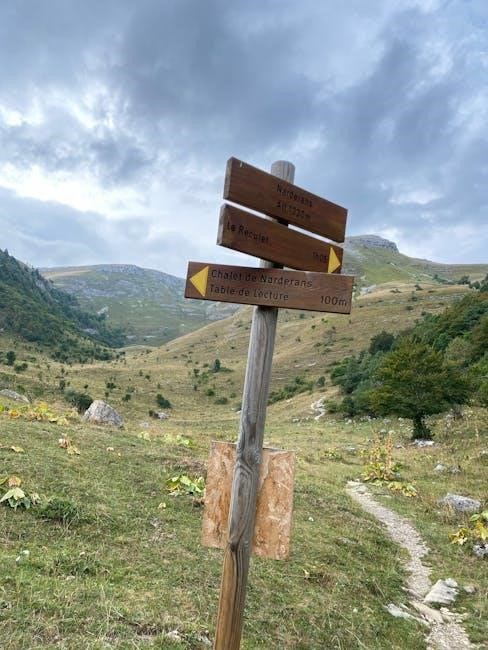Tristan Gooley, a celebrated author and explorer, presents a unique approach to navigation with his bestselling book, “The Walker’s Guide to Outdoor Clues and Signs.”
Gooley’s work emphasizes understanding the natural world as a navigational tool, offering a compelling alternative to relying solely on technology for direction.
His insights, shared through journeys and teaching, empower readers to connect with their surroundings and develop a deeper awareness of the environment.
The Author: Tristan Gooley’s Background
Tristan Gooley is an award-winning and internationally bestselling author renowned for his exploration of natural navigation. He isn’t a traditional explorer with formal training; instead, his expertise blossomed from extensive personal journeys and a deep curiosity about the natural world.
Gooley’s background is remarkably diverse, encompassing studies at Cambridge and a career in the financial world before dedicating himself to understanding and teaching the art of navigating by observing clues in the landscape.
He delivers talks and workshops, sharing his knowledge and inspiring others to connect with their surroundings, becoming a Sunday Times Bestselling author.
The Book’s Core Philosophy: Natural Navigation
“The Walker’s Guide to Outdoor Clues and Signs” champions natural navigation – the art of finding your way using observations of the environment, rather than relying on maps, compasses, or GPS technology.
Gooley’s philosophy centers on the idea that the landscape is filled with subtle indicators, from sun position and wind direction to vegetation patterns and animal behavior, all offering directional cues;
The book encourages a mindful approach to walking, fostering a deeper connection with nature and empowering individuals to become more self-reliant and observant explorers.

Understanding Natural Navigation Principles
Natural navigation, as taught by Tristan Gooley, hinges on recognizing patterns and clues within the natural world to determine direction and location effectively.
The Importance of Observation Skills
Tristan Gooley’s “The Walker’s Guide” fundamentally stresses the critical role of keen observation. He argues that natural navigation isn’t about possessing innate skills, but rather cultivating a mindful awareness of subtle environmental details.
This involves actively noticing and interpreting seemingly insignificant clues – the texture of bark, the direction of prevailing winds, or the arrangement of vegetation. Gooley encourages walkers to move beyond simply looking at the landscape, and instead, to truly see it.
Developing this observational ability is the cornerstone of his method, allowing individuals to decipher the natural world’s hidden language and navigate with confidence.
Utilizing Multiple Senses – Beyond Sight
Tristan Gooley expands navigational awareness beyond visual cues in “The Walker’s Guide,” advocating for a multi-sensory approach. He emphasizes that the natural world communicates through more than just what we see.
Listening to the wind, feeling the temperature changes, and even noticing subtle scents can provide valuable directional information. Gooley details how to interpret these often-overlooked signals, enhancing navigational accuracy.
By engaging all senses, walkers can build a richer understanding of their surroundings and develop a more intuitive connection with the landscape, fostering a deeper sense of place.

Reading the Landscape: Key Clues
Tristan Gooley’s “The Walker’s Guide” unlocks the secrets hidden within the landscape, teaching readers to decipher natural signs for direction and orientation.
He reveals how subtle clues—from sun position to wind patterns—offer a wealth of navigational information to observant walkers.
Sun Position and Shadow Telling
Tristan Gooley details how understanding the sun’s arc across the sky is fundamental to natural navigation, as outlined in “The Walker’s Guide.” He explains that observing shadow length and direction provides a reliable compass, even on cloudy days.
Gooley emphasizes that the sun rises roughly in the east and sets in the west, but these points shift seasonally. By noting the sun’s position at different times, walkers can establish a sense of direction.
He also highlights the importance of understanding how shadows shorten and lengthen throughout the day, offering a dynamic, natural clock and directional guide.
Wind Direction and its Indicators
Tristan Gooley’s “The Walker’s Guide” stresses the significance of wind as a consistent directional cue. He details how to interpret subtle indicators, moving beyond simply feeling the breeze on your face.
Gooley explains that prevailing wind directions shape the landscape, influencing tree growth and the distribution of snow. Observing these patterns reveals consistent directional information.
He also highlights how flags, smoke, and even the drift of sand can provide immediate clues to wind direction, offering walkers a readily available navigational tool in diverse environments.
Vegetation as a Navigational Tool
Tristan Gooley emphasizes that vegetation offers remarkable navigational clues in “The Walker’s Guide.” He details how plants respond to environmental factors, revealing directional information to observant walkers.
Gooley explains that consistent wind exposure and sunlight influence tree shapes and growth patterns, creating subtle but reliable indicators of direction. He encourages careful observation of these features.
Furthermore, he explores how plant species distribution can signal prevailing conditions, providing a broader understanding of the landscape and aiding in accurate orientation and route-finding.
Moss Growth and Tree Distribution
Tristan Gooley, in “The Walker’s Guide,” highlights moss growth as a surprisingly accurate directional indicator. He notes that moss tends to flourish on the shadier, damper sides of trees – typically the north side in the Northern Hemisphere.
However, Gooley cautions against relying solely on this, as local conditions can create variations. He also explains how prevailing winds shape tree distribution, often causing trees to lean away from the dominant wind direction.
Combining these observations – moss growth and tree lean – provides a more robust and reliable navigational assessment.
Plant Species as Directional Indicators

Tristan Gooley’s “The Walker’s Guide” details how certain plant species exhibit directional preferences. He explains that some plants consistently grow towards sunlight, offering clues about cardinal directions.
For example, observing the growth patterns of vines or the orientation of leaves can reveal subtle indicators of south-facing slopes or prevailing sunlight exposure.
Gooley emphasizes that understanding local flora and their growth habits is crucial, as these indicators are highly dependent on specific environments and plant types.

Celestial Navigation Techniques
Tristan Gooley demonstrates how constellations, like Orion, can serve as reliable directional guides when visibility allows, offering a timeless navigational method.
He teaches readers to utilize star positions for determining direction, even in the absence of modern tools, fostering self-reliance in the outdoors.
Using the Stars for Direction
Tristan Gooley emphasizes that celestial navigation isn’t about memorizing complex charts, but understanding fundamental relationships between stars and direction. He highlights how even basic observation can yield surprisingly accurate results.
The author explains that identifying key constellations, such as Orion, provides a fixed reference point, especially crucial during periods of darkness or when other landmarks are obscured.
Gooley’s approach focuses on practical application, teaching walkers to discern cardinal directions by observing the apparent movement of stars across the night sky, fostering a deeper connection with the natural world.
The Role of Constellations (e;g., Orion)
Tristan Gooley demonstrates how constellations, particularly Orion, serve as reliable navigational beacons. He explains that Orion’s consistent visibility and distinct shape make it an ideal starting point for direction-finding.
Gooley details how observing Orion’s rise and set points, alongside its position relative to the horizon, can indicate approximate cardinal directions, even without a compass.
He stresses that understanding a constellation’s seasonal appearance and predictable movements is key to utilizing it effectively as a natural navigational tool, enhancing outdoor awareness.

Animal Behavior as a Guide
Tristan Gooley highlights how observing animal movements—like bird migration patterns—can reveal directional cues, offering walkers insights into prevailing winds and routes.
Bird Migration Patterns
Tristan Gooley’s “The Walker’s Guide” details how understanding bird migration isn’t just about knowing where birds are going, but when and how they travel.
He explains that consistent flight directions, especially during peak migration seasons, can indicate prevailing wind directions and, consequently, general geographical orientations.
Observing the time of day birds take flight, and the altitude at which they fly, provides further clues. Gooley emphasizes that these observations require patience and a keen awareness of seasonal changes.
By interpreting these avian behaviors, walkers can gain a natural sense of direction, supplementing other navigational techniques.
Animal Trails and Habitats
Tristan Gooley’s guide highlights how animal trails often follow contours, seeking the easiest routes across terrain – frequently indicating downhill paths and potential water sources.
He stresses observing the types of animals present in a habitat; their preferences reveal information about the landscape’s characteristics, like soil type or vegetation.
For example, certain animals favor south-facing slopes for warmth, while others seek shaded, north-facing areas. Analyzing these habitat choices offers directional insights.
Gooley cautions against relying solely on trails, as they can be misleading, but emphasizes their value when combined with other observations.

Weather Patterns and Forecasting
Tristan Gooley teaches interpreting cloud formations and atmospheric pressure changes as natural forecasting tools, enabling walkers to anticipate shifts and adjust plans accordingly.
Understanding these patterns enhances safety and awareness while navigating outdoors, offering a deeper connection with the environment.
Reading Cloud Formations
Tristan Gooley’s “The Walker’s Guide” details how cloud types reveal impending weather changes. Cumulus clouds, for example, often signal fair weather, while darkening, towering cumulonimbus formations indicate potential storms.
He explains that observing cloud movement—direction and speed—can also predict wind shifts. Lenticular clouds, resembling lenses, often form near mountains and suggest turbulent conditions.
Gooley emphasizes that consistent observation and understanding these visual cues allow walkers to anticipate weather patterns, enhancing safety and informed decision-making during outdoor adventures. Recognizing these formations is a crucial skill.
Interpreting Atmospheric Pressure
Tristan Gooley highlights that changes in atmospheric pressure are key indicators of approaching weather systems. Falling pressure generally suggests an incoming low-pressure system, often bringing clouds and precipitation.
Conversely, rising pressure typically indicates a high-pressure system, associated with settled, fair weather. While a barometer provides precise readings, Gooley details how to sense pressure changes through physical sensations.
These include joint pain or headaches, and observing animal behavior. Understanding these subtle cues, combined with cloud observations, allows walkers to anticipate shifts in weather conditions effectively.

Practical Applications for Walkers
Tristan Gooley’s methods empower walkers to combine observed clues, fostering a “navigation mindset” – a heightened awareness of surroundings for accurate, intuitive direction-finding.
Combining Clues for Accuracy
Tristan Gooley stresses that relying on a single clue is insufficient for reliable navigation; instead, walkers should synthesize multiple observations. For example, correlating sun position with wind direction and vegetation patterns creates a more robust understanding of one’s location.
He advocates for cross-referencing indicators – if moss growth suggests a direction, does that align with prevailing wind patterns and the angle of the sun? This layered approach minimizes errors and builds confidence.
Gooley’s techniques aren’t about finding definitive answers, but about building a probabilistic understanding of the landscape, constantly refining direction based on accumulating evidence;
Developing a “Navigation Mindset”
Tristan Gooley emphasizes that natural navigation isn’t merely about learning techniques, but cultivating a specific way of observing the world. This “navigation mindset” involves constant questioning and a heightened awareness of subtle environmental cues.
It’s about shifting from passively walking through a landscape to actively reading it, noticing details others overlook. Gooley encourages walkers to treat every journey as a learning opportunity, continually testing and refining their observational skills.
This mindset fosters a deeper connection with nature and empowers individuals to navigate confidently, even without traditional tools.

Limitations and Cautions
Tristan Gooley acknowledges that natural navigation is influenced by local conditions and isn’t foolproof; therefore, always carry backup navigational tools for safety and reliability.
The Impact of Local Variations
Tristan Gooley’s methods, while insightful, are significantly affected by geographical nuances. The reliability of indicators like moss growth or wind patterns varies dramatically based on regional climate and terrain.
For example, moss doesn’t always grow predominantly on the north side of trees, and prevailing wind directions shift across landscapes. Understanding these local deviations is crucial; a blanket application of rules can lead to misinterpretation.
Gooley stresses the importance of observing and adapting to the specific characteristics of each environment, recognizing that nature’s clues are rarely universally consistent.
The Need for Backup Navigation Methods
Tristan Gooley consistently advocates for layering navigational techniques, emphasizing that natural navigation shouldn’t be a sole reliance. Environmental factors can be misleading, and interpretations are subject to error, even with practiced observation.
Therefore, combining natural clues with traditional methods – map, compass, and GPS – provides a robust safety net. These tools offer verifiable data, mitigating risks associated with relying solely on potentially ambiguous natural signs.
Gooley’s approach isn’t about replacing conventional navigation, but enriching it with a deeper understanding of the natural world.

Gooley’s Other Works and Resources
Tristan Gooley is a prolific author, with additional books expanding on natural navigation and observation skills, alongside workshops for deeper learning.
Explore his wider body of work to further refine your understanding of the natural world and its navigational secrets.
Related Books by Tristan Gooley
Tristan Gooley has authored several acclaimed books that complement “The Walker’s Guide.” “Natural Navigation” delves into the core principles of finding your way using the sun, stars, and landscape features, providing a foundational understanding.
“How to Read Water” explores the subtle clues hidden within bodies of water, offering insights into weather, direction, and the surrounding environment. “The Lost Art of Reading Maps” reconnects readers with traditional cartography skills, emphasizing map interpretation and terrain association.
Furthermore, “Wild Signs and Birdsong” expands observational skills to include animal behavior and vocalizations, enriching the natural navigation experience. These books collectively demonstrate Gooley’s dedication to fostering a deeper connection with the natural world.
Online Resources and Workshops
Tristan Gooley actively engages with enthusiasts through various online platforms and in-person workshops. His official website serves as a central hub for information, featuring articles, blog posts, and details about upcoming events.
Linghams Bookshop frequently hosts talks and presentations by Gooley, offering opportunities for direct interaction and deeper exploration of his techniques. Workshops, often held in natural settings, provide hands-on experience in applying natural navigation principles.
Social media channels offer further engagement, with Gooley sharing insights and responding to questions from his growing community of followers and outdoor enthusiasts.